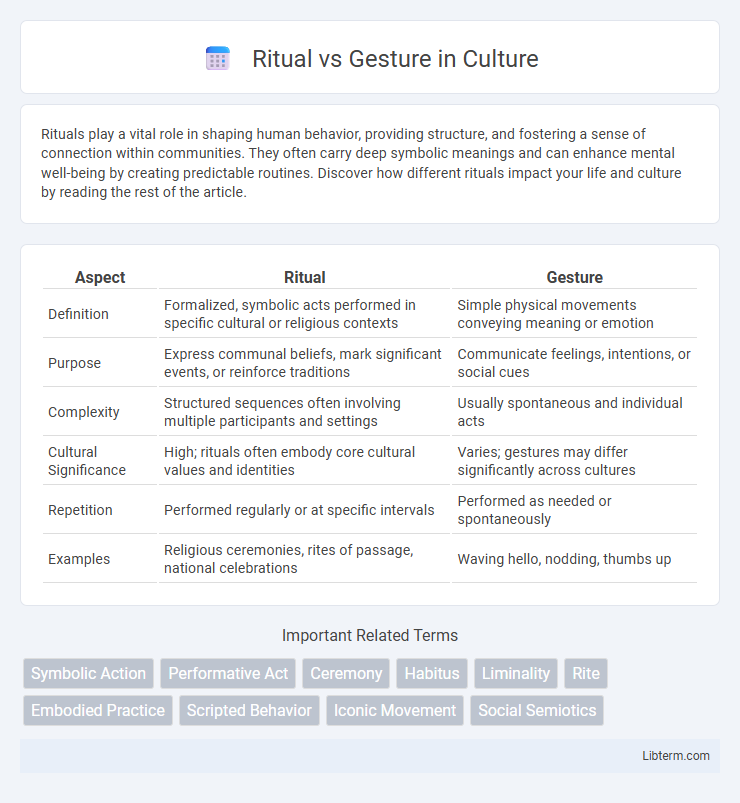Rituals play a vital role in shaping human behavior, providing structure, and fostering a sense of connection within communities. They often carry deep symbolic meanings and can enhance mental well-being by creating predictable routines. Discover how different rituals impact your life and culture by reading the rest of the article.
Table of Comparison
| Aspect | Ritual | Gesture |
|---|---|---|
| Definition | Formalized, symbolic acts performed in specific cultural or religious contexts | Simple physical movements conveying meaning or emotion |
| Purpose | Express communal beliefs, mark significant events, or reinforce traditions | Communicate feelings, intentions, or social cues |
| Complexity | Structured sequences often involving multiple participants and settings | Usually spontaneous and individual acts |
| Cultural Significance | High; rituals often embody core cultural values and identities | Varies; gestures may differ significantly across cultures |
| Repetition | Performed regularly or at specific intervals | Performed as needed or spontaneously |
| Examples | Religious ceremonies, rites of passage, national celebrations | Waving hello, nodding, thumbs up |
Understanding Rituals and Gestures
Rituals are structured, symbolic actions performed with cultural or religious significance, often following established patterns that reinforce community values and identity. Gestures are spontaneous or habitual physical movements used to communicate emotions, intentions, or social cues in everyday interactions. Understanding rituals involves recognizing their collective, meaningful context, while gestures require interpreting individual expressions within social communication.
Defining Rituals: Key Characteristics
Rituals are structured, repetitive actions imbued with symbolic meaning performed within specific cultural or social contexts, reinforcing shared beliefs and values. Key characteristics include a prescribed sequence, communal participation, and intentional purpose, often marking important life events or transitions. Unlike casual gestures, rituals invoke a deeper collective significance that transcends individual expression.
What Constitutes a Gesture?
A gesture is a deliberate physical movement or action performed to convey meaning or communicate an idea nonverbally. It can include hand signals, facial expressions, or body postures, often context-dependent and culturally specific. Unlike rituals, gestures are typically spontaneous and serve immediate communicative purposes rather than symbolic ceremonies or repeated traditions.
Historical Origins of Rituals and Gestures
Rituals trace back to ancient civilizations where structured ceremonies served as communal acts to reinforce social bonds and religious beliefs, often codified in sacred texts or traditions. Gestures, meanwhile, originated as instinctual, nonverbal communications that evolved into culturally specific signs conveying intentions or emotions without spoken language. The historical divergence highlights how rituals formalize collective experiences, whereas gestures remain immediate, personal expressions embedded in daily interactions.
Cultural Significance: Rituals vs Gestures
Rituals hold profound cultural significance as structured, symbolic ceremonies that reinforce communal values and traditions within societies. Gestures, while often culturally specific, serve as immediate nonverbal communication tools reflecting social norms and interpersonal relationships. The depth of meaning in rituals surpasses that of gestures by embedding collective identity and continuity across generations.
Psychological Impact of Rituals and Gestures
Rituals create a profound psychological impact by providing structure, meaning, and a sense of belonging, which can reduce anxiety and enhance emotional stability. Gestures, while often brief and simple, convey powerful nonverbal communication that reinforces social bonds and empathy. Both rituals and gestures activate neural pathways associated with trust and cooperation, fostering community cohesion and personal well-being.
Rituals and Gestures in Daily Life
Rituals in daily life are structured, repetitive actions with symbolic meaning, such as morning meditation or religious prayers, which provide stability and purpose. Gestures, like waving hello or nodding, are spontaneous, nonverbal signals used to communicate emotions or intentions quickly. Both rituals and gestures enhance social interactions by conveying cultural values and fostering connection among individuals.
Symbolism Behind Rituals and Gestures
Rituals embody complex symbolism through repetitive and meaningful actions that convey cultural or spiritual significance, often marking important life events or communal identities. Gestures, while simpler and more immediate, serve as symbolic nonverbal communication that conveys emotions, intentions, or social cues within specific contexts. Both rituals and gestures function as vital symbolic mechanisms that reinforce social bonds and shared meanings across diverse cultures.
Rituals vs Gestures: Key Differences
Rituals involve a series of prescribed actions performed in a specific order, often carrying symbolic meaning within cultural or religious contexts, whereas gestures are typically spontaneous, nonverbal movements expressing emotions or intentions. Rituals are characterized by repetition and formality, reinforcing social bonds and shared values, while gestures are more individual and situational, used primarily for communication. Understanding these distinctions highlights how rituals shape collective identity, while gestures serve as immediate and personal modes of expression.
The Evolving Role of Rituals and Gestures in Modern Society
Rituals and gestures serve as fundamental expressions of culture, with rituals often embodying structured, symbolic ceremonies that reinforce social cohesion, while gestures provide immediate, nonverbal communication that conveys emotions and intentions. In modern society, the role of rituals has evolved from strictly traditional ceremonies to include digital and personalized practices that foster individual identity and community belonging. Concurrently, gestures adapt rapidly in diverse social contexts, particularly through globalized communication platforms that reshape their meanings and significance.
Ritual Infographic

 libterm.com
libterm.com